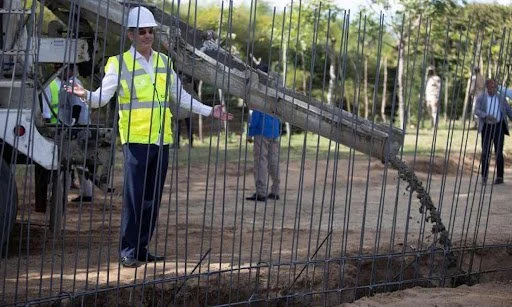The Dominican Republic Announces a Border Wall With Haiti
The Dominican Republic's president, Luis Abinader, in Dajabón as construction begins on the wall that will span nearly half the 244-mile border with Haiti. Photo: Reuters
The Dominican Republic has announced plans to create a concrete wall along the 392-kilometer border it shares with Haiti. It is expected to be 20 centimeters thick and 3.9 meters tall, with metal mesh along the top and 70 watchtowers. The wall’s purpose is to stop migrants, drugs, and weapons from crossing the border into the Dominican Republic.
Although the total cost has not yet been announced, construction has already started. The first phase of the project will take around nine months to complete. Dominican President Luis Abinader has demonstrated full support for the plan. “Each time Haiti has suffered a catastrophe, the Dominicans have always been the first to arrive with help. However, the Dominican Republic cannot take charge of the political and economic crisis in that country,” he says.
The Dominican Republic and Haiti share the island of Hispaniola, but not much else. While the former has seen a boost in its economy and development due to tourism, the latter remains the poorest country in the western hemisphere. The two countries are closely connected, both geographically and through the 500,000 Haitians currently living in the Dominican Republic. Haitians have been crossing the border for job opportunities in the agricultural and construction industries.
The refugee exodus began in 2010, after an earthquake killed 220,000 people in Haiti. However, migrants have been treated badly in most of the countries they have fled to. Over the past several months, the United States has deported 14,000 asylum seekers from Haiti without allowing them to file claims due to a pandemic rule. Mexico has sent many refugees back home as well. The Dominican Republic’s recent move is simply yet another example of a neighboring country turning its back on the problem.
Haitians routinely cross the border into the Dominican Republic to sell goods at a market in Dajabón. Photo: Ricardo Rojas/ Reuters
Haiti has been struggling with poverty, organized crime, and a political crisis. Its former president, Jovenel Moïse, was assassinated last July, sending the country into a tailspin. Moreover, a 7.2 magnitude earthquake in August worsened the already untenable situation. With rising gang violence, political deadlock, and failed elections, the Dominican Republic is hoping to stop any spillover with a physical border.
Prime Minister Ariel Henry took office after Moïse’s assassination, but many claim his administration is unconstitutional. He promised a provisional electoral council, as elections are unlikely to occur anytime soon. The legislative elections that were supposed to happen in October 2019 failed due to protests and political gridlock, so Moïse had been ruling by decree before his death. Now, with police patrolling the streets but unable to stop kidnappings and murders orchestrated by Haiti’s powerful gangs, few are willing to risk leaving their homes to vote.
Haiti’s public officials have expressed concern and anger toward the border wall, and so have some Dominicans. Mayor Santiago Riverón of Dajabón, a municipality near the border, cites bribery opportunities as a serious concern, lamenting that “now we have to work with the wall in the minds of the military, who are the ones who take advantage of the border and receive a bribe of 100 or 200 pesos to let people cross.” It is still unknown whether the border will be successful at stopping migration and contraband, as well as whether the financial and diplomatic costs will be repaid.


